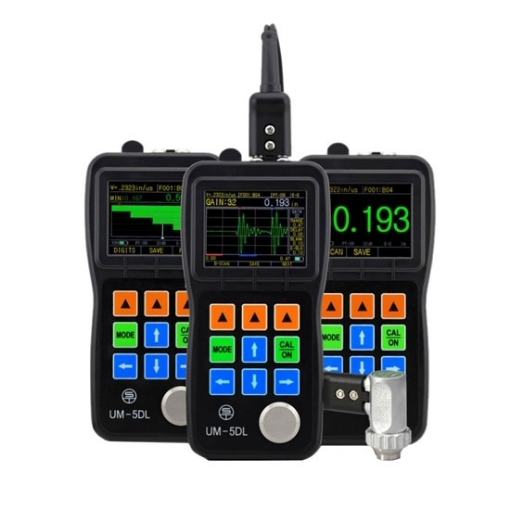A thickness gauge is an instrument used to measure the thickness of materials and objects. It is often used in industrial production to continuously or sample the thickness of products (such as steel plates, steel strips, films, paper, metal foils, etc.). There are many types of thickness gauges, including coating thickness gauges, radioactive thickness gauges, ultrasonic thickness gauges, eddy current thickness gauges, and thickness gauges that use the principle of mechanical contact measurement.
The thickness gauge is mainly used to measure the thickness of the coating. These thicknesses are very important for manufacturing and processing. For example, in the automotive industry, the coating is mainly sprayed by some equipment, and the thickness is sometimes unstable. If the coating is sprayed too thin, the smoothness of the paint surface will be affected, and its stability will also be affected, and this problem can be solved by knowing the thickness.
The thickness gauge also has a data recording function. The design and manufacture of any product require continuous improvement. How to improve it depends on some main real-time data during production. In order to obtain these data, it is necessary to use a thickness gauge to measure.
Types
According to different measurement methods, thickness gauges can be roughly divided into:
- Contact thickness gauge
The size of the contact area is divided into point contact thickness gauges and surface contact thickness gauges. - Non-contact thickness gauge
Non-contact thickness gauges can be divided into the following types according to their different testing principles: laser thickness gauge, ultrasonic thickness gauge, coating thickness gauge, X-ray thickness gauge, white light interference thickness gauge, electrolytic thickness gauge, and pipe thickness gauge.
Selection Guide
- Copper and chromium layers on plastic: It is recommended to use a coulometric thickness gauge (which will damage the coating) or an X-ray thickness gauge (non-destructive measurement). If the copper layer is 10m~200m, an eddy current method thickness gauge (non-destructive Measurement) is.
- Galvanized layer on metal parts: For example, an economical magnetic induction method thickness gauge (non-destructive measurement) should be used on the steel substrate. For other metal substrates, use a coulometric thickness gauge (which will destroy the coating) or an X-ray thickness gauge (non-destructive measurement).
- For the electrophoretic paint on the iron substrate, the economical magnetic induction method thickness gauge (non-destructive measurement) should be used for the paint. For electrophoretic paint on other metal substrates, an economical eddy current method thickness gauge (non-destructive measurement) should be used for paint.
- The dry film refers to the cured paint coating.
- Refer to item 2 and item 1 for the chrome plating layer.
- Only the shipping method (PIG, which will destroy the coating) is used for painting the interior and exterior parts of the car. The ultrasonic method (non-destructive measurement) can measure the coating above 10 microns, but sometimes it cannot be detected.
The test methods of the thickness gauge mainly include magnetic thickness measurement, radiation thickness measurement, electrolytic thickness measurement, eddy current thickness measurement, and ultrasonic thickness measurement.
Tips for Using a Thickness Gauge
- When testing, it should be noted that the metal magnetism and surface roughness of the standard piece should be similar to that of the test piece.
- When measuring, keep the side head perpendicular to the surface of the sample.
- When measuring, pay attention to the critical thickness of the base metal. If it is greater than this thickness, the measurement will not be affected by the thickness of the base metal.
- When measuring, pay attention to the influence of the curvature of the specimen on the measurement. Therefore unreliable when measuring on curved test piece surfaces.
- Before using the thickness gauge to measure, pay attention to whether other electrical equipment around will generate a magnetic field. If so, it will interfere with the magnetic thickness measurement method.
- When measuring, be careful not to measure at the inner corner or near the edge of the test piece, because the sudden change of the surface shape of the general thickness gauge test piece is very sensitive.
- Keep the pressure constant during measurement, otherwise, it will affect the measurement reading.
- When testing, pay attention to the direct contact between the measuring head of the instrument and the tested piece, so the ultrasonic thickness gauge is cleaning the attached substance on the opposite side.


